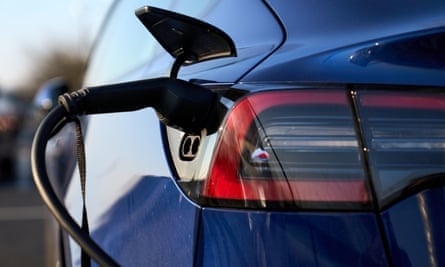When the batteries run out, what’s left is a mess. The devilish “black goo” is a shredded toxic mixture from inside battery cells that have reached the end of their useful life.
“That’s as close as we can get,” says Benjamin Wickham, director of chemical processes at startup Altilium Metals. He had been within striking distance of a tonne of the material at the battery recycling company’s test laboratory in Tavistock, on the edge of Dartmoor National Park.
That dark dust, and the valuable metals it contains, will play an increasingly important role in decarbonising the British economy in the years to come as electric vehicles become the norm. With 11 million tons of spent lithium-ion batteries expected to need recycling worldwide by 2030, it could prove to be a big growth business.
Electric cars, at least for now, cost more up front than gasoline or diesel vehicles. The main reason is that batteries need expensive metals like lithium, cobalt, nickel, and manganese, rather than the iron, aluminum, and oil needed to build and power an internal combustion engine.

The extraction of these minerals and an energy-intensive manufacturing process mean that the production of a new electric car generates more carbon than an equivalent gasoline or diesel model. However, that ignores the vast global extraction of fossil fuels needed to keep internal combustion engines running, and the unavoidable amounts of carbon they emit.
With electric cars, very little is lost to the environment. What’s more, according to Wickham, recycling the spent batteries from 100,000 vehicles could generate up to £350m in new materials.
With automakers eventually needing to reduce net emissions from auto production to zero, the vision of a circular process from old to new batteries is “less of an opportunity and more of a necessity,” says David Bott, director of innovation at the Chemical Industry Society. . “At the end of its life, a battery is just a slightly degraded version of its younger self. You just move around the electrons.”
Christian Marston, CTO and co-founder of Altilium, estimates that by around 2040 the industry could get up to 40% of its lithium from recycling, reducing the need for energy-intensive dirty mining. Recycling could save about 38% of the carbon and 35% of the cost of extracting the same materials.
“Metal can be recycled continuously almost forever,” says Marston. “What we are looking for is the complete circularity of the battery. We think of EV batteries as concentrated mineral.”
Altilium has received a £3m grant from the UK government to help set up its Tavistock centre, where it will try to prove to investors that its processes can produce chemicals pure enough to go back directly into a battery.
Lithium prices have skyrocketed throughout 2021, with some analysts warning of a looming shortage of the lightweight metal amid soaring global demand for batteries. Sarah Colbourn, a senior analyst at data firm Benchmark Mineral Intelligence, predicts “supply shortfalls and a tight market.” But the growing interest in battery recycling is also geopolitical: Europe and the US do not want to be dependent on materials from China.
“The real push in North America and Europe will be to understand that recycling can be a source of these materials,” says Colbourn.
China currently accounts for more than 70% of battery recycling capacity, he says, but American and European companies are racing to catch up and could benefit from a green subsidy war. In the US, Redwood Materials, run by former Tesla executive JB Straubel, this month secured a conditional commitment from the US government for a $2 billion loan to support the construction of a new plant in Nevada. . Other US startups working on capacity expansion include Ascend Elements, Cirba Solutions and Li-Cycle. In the EU, Belgian materials company Umicore can recycle 7,000 tonnes a year and is looking for a location to build a larger plant.
“There is a lot of noise, movement and funding happening in Europe,” said Julia Poliscanova, senior director of vehicles for the Transport & Environment campaign group. “What we lack today is consistent recycling capacity on a commercial scale.”
Battery recycling uses a relatively well-established technology that crushes the cells and then separates the plastic that contained the minerals. After that, there are two main recovery processes: pyrometallurgy recovers metals with fire, but cannot be used for lithium (the key material in the battery anode) or graphite (cathode carbon layers); hydrometallurgy uses acids in water to leach the metals.
Altilium says that laboratory tests show that its process can recover 95% of the useful material, although whether that will work on an industrial scale is another question. Marston says his base in the former stannary (tin mining) town of Tavistock in west Devon offers the opportunity to create a greener, more modern way of extracting resources. It will start processing about 100 tons of black mass next year, enough for about 300 cars.
However, it has plans for a much larger production facility in Teesside, perhaps taking advantage of tax benefits. He says this could, if successful, create 100-200 high-value jobs by 2025 and process 150,000 car batteries a year, or 50,000 tons of black mass.
It hasn’t secured the site or the investment yet, but Altilium has an advantage over some startups: The family of another co-founder, CEO Kamran Mahdavi, already owns a former copper recovery plant in Bulgaria that will be converted to process copper materials. battery. .
The Altilium Teesside project is supported by Ben Houchen, the Conservative Mayor of Tees Valley. And Green Lithium, a startup backed by commodities trader Trafigura, has selected the region for a plant to refine virgin lithium.
By 2030, there will be plenty of electric cars with failing batteries in the UK and Europe, even if the prospects for the UK gigafactory look bleak after start-up Britishvolt collapsed in January. Poliscanova says the EU and UK should legislate to stop the shipment of battery materials to China and instead help create a domestic industry.
“Instead of spending more money on research, we need to spend more money on scaling,” he says. “We need a policy to get companies to move faster and get out of labs.”






